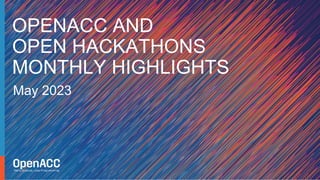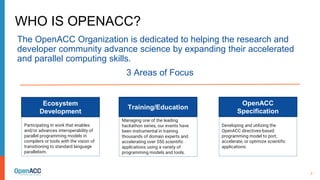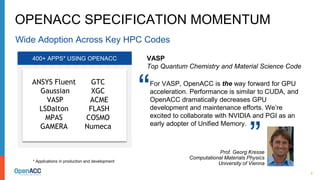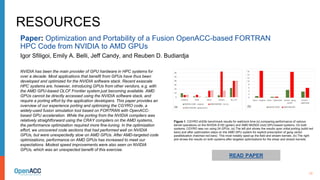OpenACC and Open Hackathons Monthly Highlights May 2023.pdf
- 1. May 2023 OPENACC AND OPEN HACKATHONS MONTHLY HIGHLIGHTS
- 2. 2 WHO IS OPENACC? The OpenACC Organization is dedicated to helping the research and developer community advance science by expanding their accelerated and parallel computing skills. 3 Areas of Focus Ecosystem Development Training/Education OpenACC Specification Participating in work that enables and/or advances interoperability of parallel programming models in compilers or tools with the vision of transitioning to standard language parallelism. Managing one of the leading hackathon series, our events have been instrumental in training thousands of domain experts and accelerating over 550 scientific applications using a variety of programming models and tools. Developing and utilizing the OpenACC directives-based programming model to port, accelerate, or optimize scientific applications.
- 3. 3 silica IFPEN, RMM-DIIS on P100 OPENACC SPECIFICATION MOMENTUM Wide Adoption Across Key HPC Codes ANSYS Fluent Gaussian VASP LSDalton MPAS GAMERA GTC XGC ACME FLASH COSMO Numeca 400+ APPS* USING OPENACC Prof. Georg Kresse Computational Materials Physics University of Vienna For VASP, OpenACC is the way forward for GPU acceleration. Performance is similar to CUDA, and OpenACC dramatically decreases GPU development and maintenance efforts. WeŌĆÖre excited to collaborate with NVIDIA and PGI as an early adopter of Unified Memory. ŌĆ£ ŌĆ£ VASP Top Quantum Chemistry and Material Science Code * Applications in production and development
- 4. 4 SUBMIT A TALK Attended an Open Hackathon and optimized your HPC or AI project? Accelerated your scientific code using the OpenACC specification? Submit a talk proposal for the upcoming Open Accelerated Computing Summit (OACS), scheduled for October 4-5, 2023. This digital event highlights research from preeminent scientists and developers around the world, exploring interesting uses cases for OpenACC, insights gained from attending an Open Hackathons, and the latest developments in parallel programming and performance interoperability. CALL FOR SPEAKERS NOW OPEN Open Accelerated Computing Summit (OACS)
- 5. 5 UPCOMING OPEN HACKATHONS & BOOTCAMPS COMPLETE LIST OF EVENTS Event Call Closes Event Date Hackathon Readiness Bootcamp: Americas June 14, 2023 June 28, 2023 Hackathon Readiness Bootcamp: Europe June 14, 2023 June 28, 2023 Hong Kong AI for Science Bootcamp June 6, 2023 June 28, 2023 Hackathon Readiness Bootcamp: Asia June 14, 2023 June 29, 2023 NCHC N-Ways to GPU Programming Bootcamp July 4, 2023 July 27-28, 2023 Wuhan University Open Hackathon June 20, 2023 July 25, August 1-4, 2023 BNL Open Hackathon June 19, 2023 August 15, 22-24, 2023 NASA Open Hackathon June 20, 2023 September 12, 19-21, 2023 NSM Open Hackathon August 9, 2023 September 26, October 3-6, 2023 Digital in 2023: Our virtual events continue to offer the same high-touch training and mentorship without the hassle of travel!
- 6. 6 READ THE INTERVIEW Read the interview with Sunita Chandrasekaran, User Group Chair of the OpenACC organization and associate professor with the Department of Computer and Information Sciences at the University of Delaware, as she discusses ever-evolving hardware, sustainable software and preparing the next-generation workforce. INNOVATION LEADERS: A CONVERSATION WITH SUNITA CHANDRASEKARAN I look forward to continuing working with application developers and optimistically addressing the growing gap between hardware and software to enable science. Collaboratively, let us build maintainable, sustainable, portable yet reliable, and performant software. ŌĆ£ ŌĆ£ Sunita Chandrasekaran User Group Chair, OpenACC Associate Professor, University of Delaware
- 7. 7 READ THE ARTICLE After nearly seven years of service, thousands of user projects, and tens of billions of compute hours, the Cori supercomputer at the National Energy Research Scientific Computing Center (NERSC) will be retired at the end of May. With its first cabinets installed in 2015 and the system fully deployed by 2016, Cori has been in service longer than any supercomputer in NERSCŌĆÖs 49-year history and enabled more than 10,000 scientific publications. CORI SUPERCOMPUTER RETIRED AT END OF MAY Bids NERSC and HPC Community Adieu
- 8. 8 LEARN MORE Calls are closing on June 16th for the U.S. Department of EnergyŌĆÖs (DOE) Innovative and Novel Computational Impact on Theory and Experiment (INCITE) program. Open to researchers around the world from academia, industry and government agencies, the INCITE program offers the opportunity to pursue transformational advances in science and technology through large allocations of computer time and supporting resources at the Argonne Leadership Computing Facility (ALCF) and the Oak Ridge Leadership Computing Facility (OLCF). Proposals may request periods of performance from one to three years. CALLS CLOSING: DOE INCITE PROGRAM Advance Science and Engineering
- 9. 9 REGISTER NOW In this webinar, Ronald M. Caplan, a computational scientist at Predictive Science Inc., looks at the current capabilities and performance of using ŌĆśdo concurrentŌĆÖ (DC) in a production application called Magnetohydrodynamic Algorithm outside a Sphere (MAS). MAS, a state-of-the-art model for studying the SunŌĆÖs corona and heliosphere, is over 70,000 lines long and has previously been ported to GPUs using MPI+OpenACC. This work attempts to eliminate as many of its OpenACC directives as possible in favor of DC. UPCOMING WEBINAR: Accelerating a Production Solar MHD Code with Fortran Standard Parallelism July 11, 2023 | 10 AM PDT
- 10. 10 REGISTER NOW In this webinar, Pedro Valero Lara, a computer scientist at Oak Ridge National Laboratory (ORNL), presents an alternative OpenACC backend for Kokkos: KokkACC. KokkACC provides a high-productivity programming environment and --potentially- - a multidevice backend. Attendees will learn more about metaprogramming solutions such as Kokkos, the capacity of OpenACC as an abstraction level for heterogeneous computing, and explore auto-tuning techniques based on analytical models for transparent device selection. UPCOMING WEBINAR: KokkACC: Enhancing Kokkos with OpenACC September 12, 2023 | 10 AM PDT
- 11. 11 RESOURCES Agent based modeling (ABM) offers a powerful abstraction for scientific study in a broad range of domains. The use of agent based simulators encourages good software engineering design such as separation of concerns, that is, the uncoupling of the model description from its implementation detail. A major limitation in current approaches to ABM simulation is that of the trade off between simulator flexibility and performance. It is common that highly optimised simulations, such as those which target graphics processing units (GPU) hardware, are implemented as standalone software. This work presents a software framework (FLAME GPU 2) which balances flexibility with performance for general purpose ABM. Methods for ensuring high computational efficacy are demonstrated by, minimising data movement, and ensuring high device utilisation by exploiting opportunities for concurrent code execution within a model and through the use of ensembles of simulations. A novel hierarchical sub- modeling approach is also presented which can be used to model certain types of recursive behaviours. This feature is shown to be essential in providing a mechanism to resolve competition for resources between agents within a parallel environment which would otherwise introduce race conditions. To understand the performance characteristics of the software, a benchmark model with millions of agents is used to explore the use of simulation ensembles and to parametrically investigate concurrent code execution within a model. Performance speedups are demonstrated of 3.5X and 10x respectively over a baseline GPU implementation. Our hierarchical sub-modeling approach is used to demonstrate the implementation of a recursive algorithm to resolve competition of agent movement which occurs as a result of agent desire to simultaneously occupy discrete areas high in a ŌĆśresourceŌĆÖ. The algorithm is used to implement a classical socio-economics model, Sugarscape, with populations of up to 16M agents. READ PAPER Paper: FLAME GPU 2: A Framework for Flexible and Performant Agent Based Simulation on GPUs Paul Richmond, Robert Chisholm, Peter Heywood, Mozhgan Kabiri Chimeh, and Matthew Leach Figure 2: The FLAME GPU simulation (execution) API components. The components are broadly categorised as inputs, execution, and outputs. The dotted lines show functional clustering of components which span over the categories. The model and logging options are used by by CUDASimulation and CUDAEnsemble. Population and visualisation components are unique to single simulations with CUDASimulation and run plans are unique to ensembles of simulation with CUDAEnsemble.
- 12. 12 RESOURCES Cloud microphysics is one of the most time-consuming components in a climate model. In this study, we port the cloud microphysics parameterization in the Community Atmosphere Model (CAM), known as Parameterization of Unified Microphysics Across Scales (PUMAS), from CPU to GPU to seek a computational speedup. The directive-based methods (OpenACC and OpenMP target offload) are determined as the best fit specifically for our development practices, which enable a single version of source code to run either on the CPU or GPU, and yield a better portability and maintainability. Their performance is first examined in a PUMAS stand-alone kernel and the directive-based methods can outperform a CPU node as long as there is enough computational burden on the GPU. A consistent behavior is observed when we run PUMAS on the GPU in a practical CAM simulation. A 3.6├Ś speedup of the PUMAS execution time, including data movement between CPU and GPU, is achieved at a coarse horizontal resolution (8 NVIDIA V100 GPUs against 36 Intel Skylake CPU cores). This speedup further increases up to 5.4├Ś at a high resolution (24 NVIDIA V100 GPUs against 108 Intel Skylake CPU cores), which highlights the fact that GPU favors larger problem size. This study demonstrates that using GPU in a CAM simulation can save noticeable computational costs even with a small portion of code being GPU-enabled. Therefore, we are encouraged to port more parameterizations to GPU to take advantage of its computational benefit. READ PAPER Paper: Acceleration of the Parameterization of Unified Microphysics Across Scales (PUMAS) on the Graphics Processing Unit (GPU) With Directive-Based Methods Jian Sun, John M. Dennis, Sheri A. Mickelson, Brian Vanderwende, Andrew Gettelman, and Katherine Thayer-Calder Figure 1. The CPU (one full compute node, 36 MPI ranks) and GPU (one MPI rank and one V100 GPU) performance (y-axis: log scale) of the PUMAS stand-alone-kernel on Casper for the different number of columns, per node or GPU (x-axis: log scale). The solid lines refer to the baseline )denoted as BSL( and the dotted lines refer to the GPU performance with the revised implementation of loops containing data dependency (denoted as OPTI).
- 13. 13 RESOURCES NVIDIA has been the main provider of GPU hardware in HPC systems for over a decade. Most applications that benefit from GPUs have thus been developed and optimized for the NVIDIA software stack. Recent exascale HPC systems are, however, introducing GPUs from other vendors, e.g. with the AMD GPU-based OLCF Frontier system just becoming available. AMD GPUs cannot be directly accessed using the NVIDIA software stack, and require a porting effort by the application developers. This paper provides an overview of our experience porting and optimizing the CGYRO code, a widely-used fusion simulation tool based on FORTRAN with OpenACC- based GPU acceleration. While the porting from the NVIDIA compilers was relatively straightforward using the CRAY compilers on the AMD systems, the performance optimization required more fine-tuning. In the optimization effort, we uncovered code sections that had performed well on NVIDIA GPUs, but were unexpectedly slow on AMD GPUs. After AMD-targeted code optimizations, performance on AMD GPUs has increased to meet our expectations. Modest speed improvements were also seen on NVIDIA GPUs, which was an unexpected benefit of this exercise. READ PAPER Paper: Optimization and Portability of a Fusion OpenACC-based FORTRAN HPC Code from NVIDIA to AMD GPUs Igor Sfiligoi, Emily A. Belli, Jeff Candy, and Reuben D. Budiardja Figure 1. CGYRO sh03b benchmark results for wallclock time (s) comparing performance of various kernel operations on the NVIDIA A100 (green) and AMD MI250X (red) GPU-based systems. On both systems, CGYRO was run using 24 GPUs. (a) The left plot shows the results upon initial porting (solid red bars) and after optimization steps on the AMD GPU system for explicit prescription of gang vector parallelization (hatched red bars). This most notably sped-up the field and stream kernels. (b) The right plot shows the results on both systems after targeted optimizations for the shear and stream kernels.
- 14. 14 RESOURCES Website: OpenHackathons.org Technical Resources VISIT SITE Explore a wealth of resources for parallelization and accelerated computing across HPC, AI and Big Data. Review a collection of videos, presentations, GitHub repos, tutorials, libraries, and more to help you advance your skills and expand your knowledge.
- 15. 15 STAY IN THE KNOW: JOIN THE COMMUNITY OPENACC AND HACKATHON UPDATES JOIN TODAY The OpenACC Organization is dedicated to helping the research and developer community advance science by expanding their accelerated and parallel computing skills. Take an active role in influencing the future of both the OpenACC specification and the organization itself by becoming a member of the community. Keep abreast of the new tools, latest resources, recent research, and upcoming events.
















